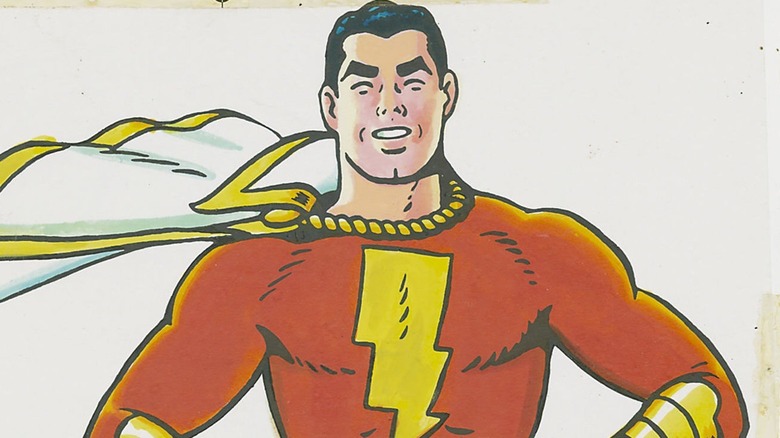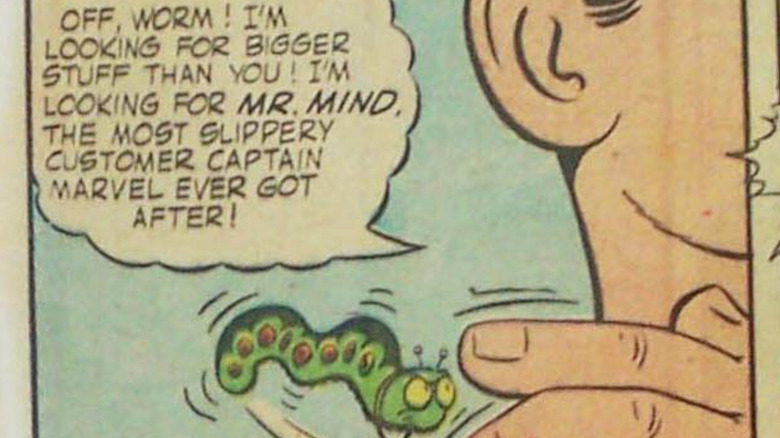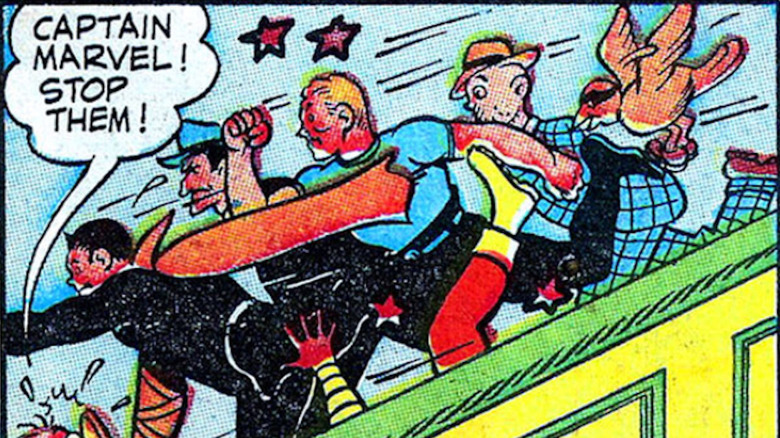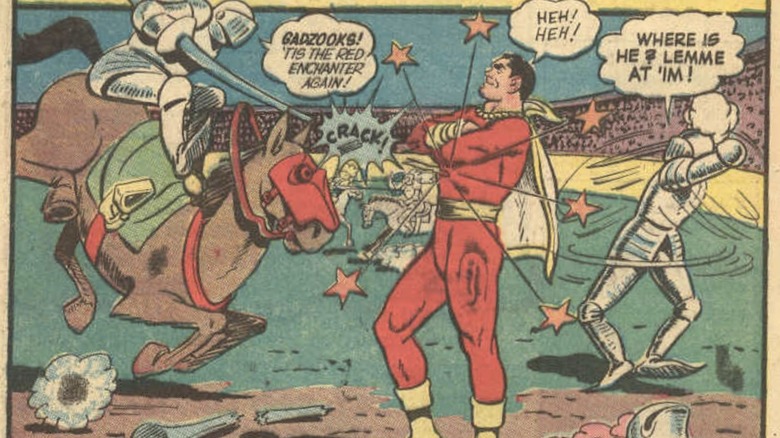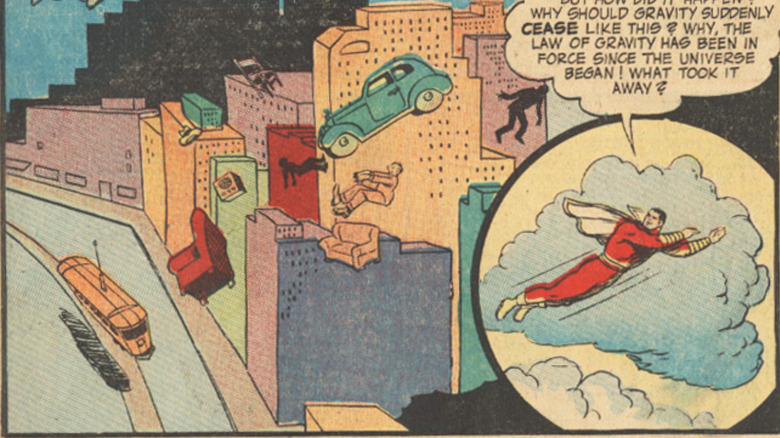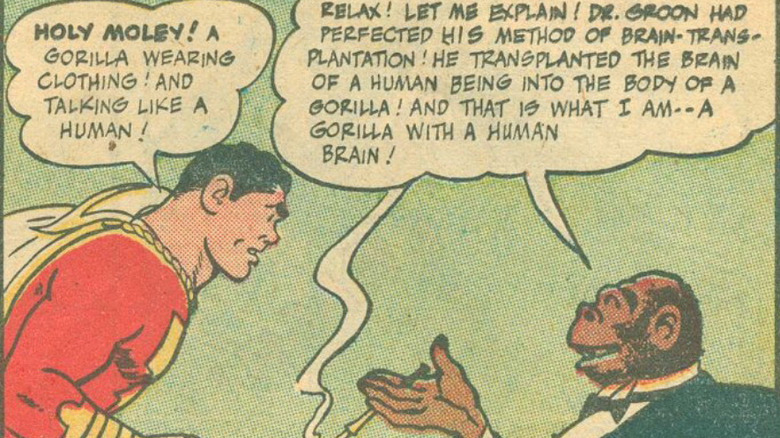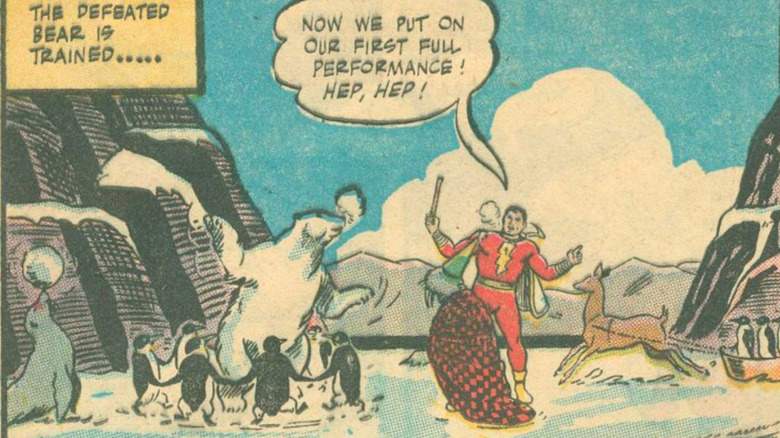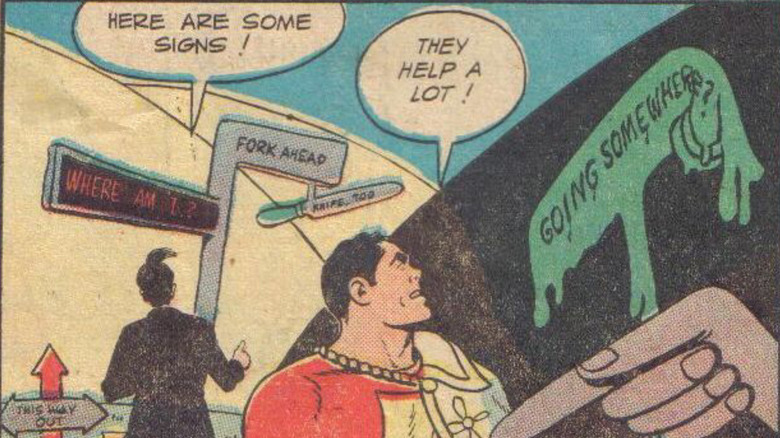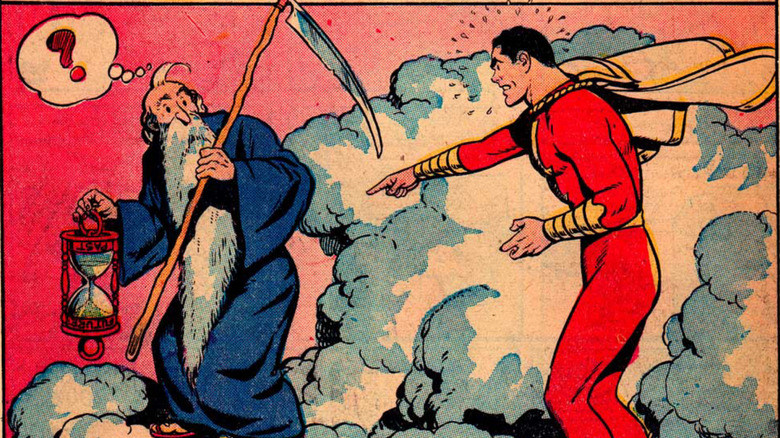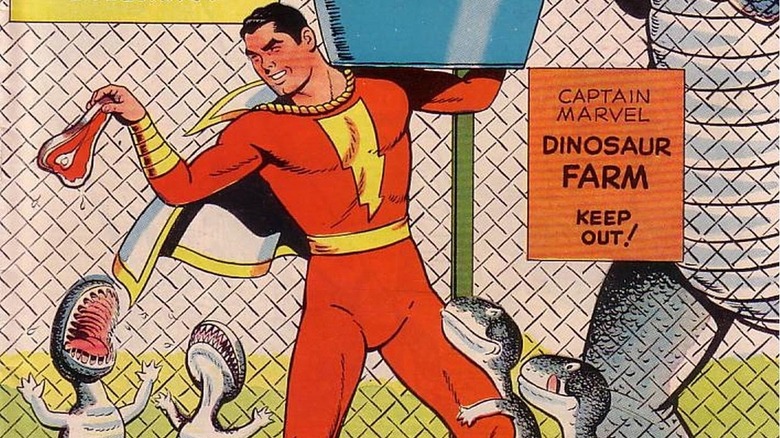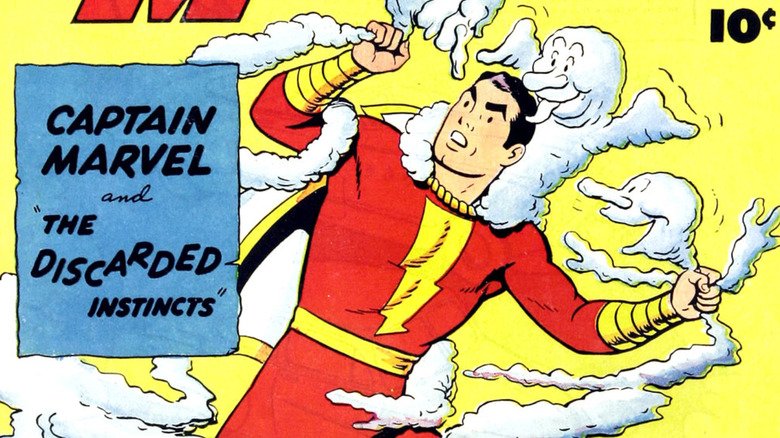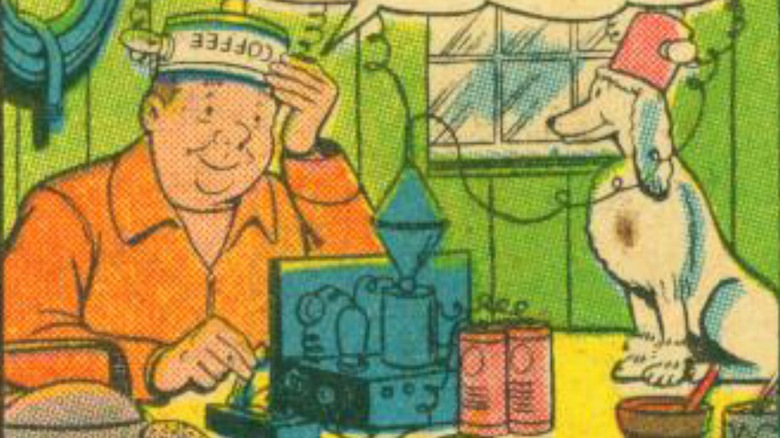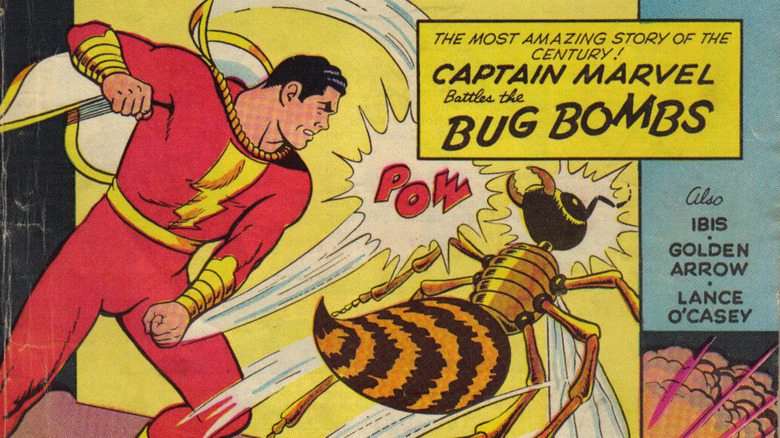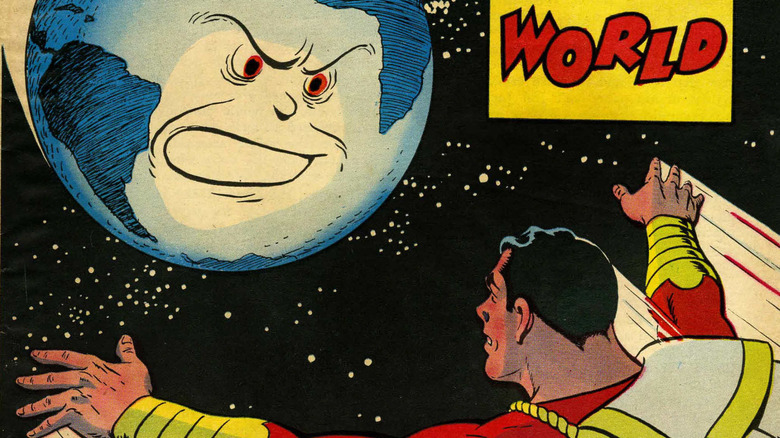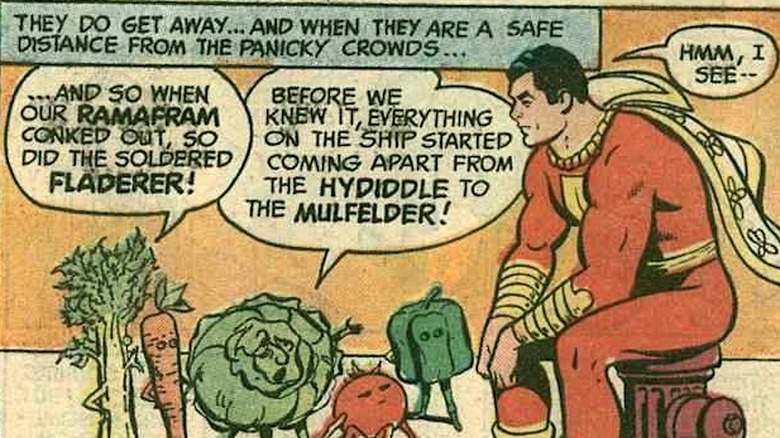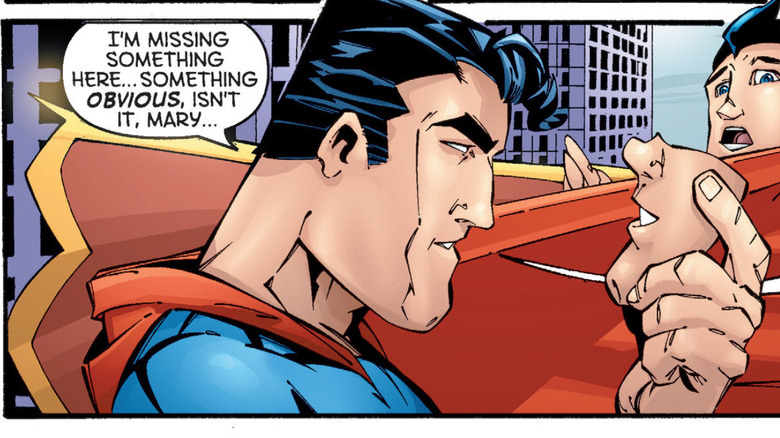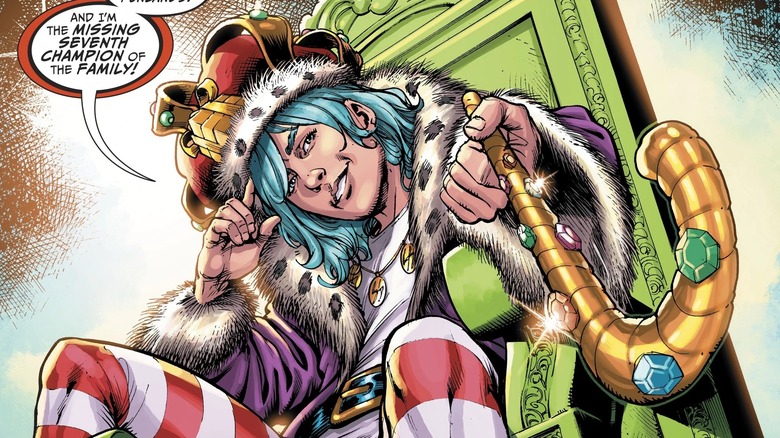Shazam's Most Bizarre Comic Book Stories Of All Time
Long before he was the star of DC's blockbuster "Shazam!" movies, before he was even called Shazam, the original Captain Marvel was the biggest threat to DC's dominance of the superhero genre. Fawcett Comics' stories of Billy Batson, the street-urchin-turned-boy-reporter who received the powers of Solomon, Hercules, Atlas, Zeus, Achilles, and Mercury from the Egyptian wizard Shazam were so huge that they outsold even those of Superman. Creators like Otto Binder and C.C. Beck ensured Shazam's success by going weirder and wackier than anything their rivals could come up with. A talking tiger in a checkered suit was a regular cast member, elves and gnomes were as likely to be behind the latest threat as any human villain, and Captain Marvel discovered new elements and lost civilizations as often as most of us find change in the couch.
Kids ate it up, and DC hit back by taking Fawcett to court for infringing on Superman in a court battle that lasted a dozen years before Fawcett finally conceded. But 20 years later, a strange twist of fate would bring Captain Marvel back into circulation at the same company that benched him in the first place. And another would keep him from using his name: In the intervening years a new publisher named Marvel had taken over the industry and introduced its own Captain Marvel. So DC's revival took the name "Shazam!" and it stuck.
Long story short, the real-life history behind Shazam is already plenty bizarre. So you can imagine how far out there his fictional adventures could get. Let's take a look.
The one where a space caterpillar was behind the Axis
Nowadays, comic book stories routinely go on for years, so it can be difficult to imagine what an innovation Captain Marvel's adventure "The Monster Society of Evil" was in 1943. At the time, stories rarely took up more than 10 pages, and serials were even rarer, let alone the two-year marathon run Otto Binder and C.C. Beck took on "Monster Society" in "Captain Marvel Adventures" #22–46.
It's not so easy to forget how bizarre the story is. The Monster Society is an interplanetary cabal run by an unseen, seemingly omniscient mastermind named Mr. Mind. He has the entire resources of the Axis Powers at his disposal: Even Hitler himself happily takes orders. After months of nearly dying at Mr. Mind's hands, Captain Marvel finds out who he is — a caterpillar with cute little glasses who could have slunk out of a Disney cartoon.
Not that this makes him any less of a threat: Not long after this discovery, Mr. Mind turns the Great Wall of China into a giant shield for the invading Japanese army. This is a story so jampacked that Binder introduces two unrelated underground civilizations in one five-page chapter, but highlights include: Mr. Mind firing so many German cannons it knocks the Earth out of orbit; building a cannon called "Great Big Bertha" that fires mile-wide shells; invading Scotland in an island-shaped battleship; and Captain Marvel warning the Scots from the back of an unfrozen mammoth.
The one where Captain Marvel put down a cartoon character strike
Captain Marvel is many things. A hero. An inspiration to generations of children. A tireless champion of freedom and democracy. Protector of magic. Charming, lovable bon vivant. But until we read this story, we never expected to add "lowdown dirty scab" to the list.
But in "Captain Marvel and the Revolt of the Comics!" in "Captain Marvel Adventures" #22, that's pretty much exactly what he is. It all starts with Billy Batson's news report at Station WHIZ being interrupted by Tarzan — sorry, "Zartan." Apparently, in the "Captain Marvel" universe, comics heroes write and draw their own stories. That becomes a problem when stand-ins for familiar (or once-familiar) characters all walk out, including Dick Tracy, Little Orphan Annie, Popeye the Sailor, and Flash Gordon. There's also a version of Batman who wears a pair of baseball bats instead of the flying kind on his chest and has an actual robin for his sidekick. (This Robin still wears a mask though, presumably to protect his secret identity. He could be any three-foot-tall talking bird!)
Whatever their grievances might be, Captain Marvel puts them back to work, whether by appealing to their patriotism (yes, comics were an essential war industry, which you would have thought they would have taught us in school) or by rescuing his fellow superheroes from a danger even they can't handle: A mob at the department store.
The one where Captain Marvel turned irreplaceable armor into scrap
With all the less than heroic things that have come out about the U.S. government in the post-Vietnam, post-Watergate world, some of the over-the-top flag-waving in wartime comics can seem a little ridiculous. But that's not true for every story. Some of them seem a lot ridiculous.
For instance, we have "Captain Marvel Visits Portland, Oregon, or Knighthood Flowers Again!" in "Captain Marvel Adventures" #29. The basic outlines of the story are already strange enough. While he's in the Pacific Northwest to promote a scrap metal drive for the war effort, Cap meets with a modern-day Don Quixote named Richard Chickenheart, whose obsession with medieval artifacts has led him to regular "spells" where he thinks he's a medieval knight. To keep him out of trouble, Billy Batson tags along as his pageboy in between turning into Captain Marvel so he can intervene when Chickenheart gets violent.
Strange stuff, but the why of it all is even weirder. Before his mental breakdown, Chickenheart is about to melt down his priceless collection of one-of-a-kind historical treasures to make into guns and tanks. All his troubles turn out to be the fault of another collector named Bart Black. Black wants to buy Chickenheart's collection for $5,000, which somehow makes him the bad guy. But no one involved seems to realize that all that money could pay for a lot more military gear than anyone could ever wring out of a couple pounds of armor.
The one where the Council of Gods repealed the law of gravity
One reason for Captain Marvel's phenomenal success was his appeal to the young children who made up the comic industry's primary market at the time. What kid wouldn't want to be able to change into an all-powerful hero? But more importantly, Captain Marvel's world runs on the kind of kiddie cosmology most of us imagine before we're old enough to understand how things really work. In these comics, natural phenomena are the work of whimsical characters like Father Time, the Seven Deadly Sins, and the Color Man.
"Captain Marvel Enforces the Law of Gravity!" in "Captain Marvel Adventures" #31 adds the Council of Gods to the series' improvised pantheon. After all, if there's a law of gravity, does that mean a court voted on it? Could they repeal it? One councilman named Gogol does, proclaiming, "It's an old cheesy law anyway!" Predictably, this is bad news back on Earth, where Captain Marvel zips around the city keeping people from floating off into space, while some gangsters take advantage of the situation by wearing spiked shoes and towing off a safe like a balloon.
Once he's dispatched them, Captain Marvel chases the problem back to the Council but gets stuck in the waiting room, along with a two-headed toad alien who lets him know he could be waiting for eternity. Fortunately, Cap has connections since the wizard Shazam used to be on the council, so he convinces Chairman Votan to expel Gogol and put the law of gravity back on the books.
The one where a mad scientist dressed up as a gorilla
Captain Marvel's adventures are full of dozens of mad scientists with elaborate schemes. But Dr. Groon from "Captain Marvel Adventures" #49 goes above and beyond. "Captain Marvel and the Unknown Killer" wastes no time on introductions: in the first panel, his medical colleagues are already banning him from his brain-transplanting experiments. Or it might just be that he looks the part: With his top hat, tails, mustache, and cane, he must be auditioning to play Snidely Whiplash.
That night, Groon seemingly returns to attack one of the doctors who denounced him before Captain Marvel intervenes. As Groon returns to take out the next man on his hit list, Captain Marvel is shocked to discover he's a gorilla in disguise. You'd think the hairy arms and legs and the cheap plastic mask that doesn't even cover his whole face would have been a tipoff, but it somehow changes expressions, so who even knows? The gorilla explains that he's the fruit of Groon's experiments, and that he killed the doctor after receiving his human brain, stole his clothes, and decided he might as well kill some more doctors while he's at it. That would be weird enough, but it doesn't end there. After the ape escapes to kill again, Captain Marvel takes another mask off him — and it turns out the gorilla is Dr. Groon after all. Crime is foiled, justice triumphs, and we're all left confused.
The one where Captain Marvel started an Arctic circus
In "Captain Marvel Adventures" #49's "Captain Marvel and His Loneliest Day," Billy Batson overhears a broadcast from the lone attendant of an iceberg-monitoring station in Greenland announcing he's going to quit before cabin fever does him in. Billy apparently decides the rest of the world can go hang for the days it will take the station to find a new attendant, because Captain Marvel's going to keep it warm himself.
As it turns out, the Stamina of Atlas doesn't extend to boredom, and it's only a few hours before Captain Marvel starts climbing up the walls. After 892 games of solitaire, he gets fed up enough to go hunting for someone to talk to, which brings us the hilarious image of Captain Marvel chatting with a penguin until, hours later, it finally covers its ears with its little flippers.
The animal-based absurdity escalates from there as Captain Marvel decides to make his own entertainment, training penguins to dance and a deer to pull them in a sleigh, then dressing up a walrus as the clown. Just so we don't go a whole story without any action, a polar bear interrupts the proceedings. But after a quick beatdown, it joins the circus with the others. Fortunately, no one witnesses the hero's spectacular breakdown except the old attendant, who happily takes his job back now that he has logic-defying entertainment to keep his mind off the solitude.
The ones where Captain Marvel went to Surrealism Land
In "Captain Marvel Adventures" #80's "Captain Marvel in the Land of Surrealism," Billy covers an art show by Surrealist painter Leonardo Vinch, who refuses a prize for imaginative art because he claims he drew it all from life. No one believes him, but Billy's at least intrigued enough to drive with Vinch to the "Goofy Grotto," where, sure enough, all the cymbal plants and eyeball flowers from Vinch's paintings actually exist. Cap has to intervene when a 50-fingered monstrosity traps Vinch to paint him — and later Cap comes to the creature's defense when his colleagues, just like Vinch's, can't believe what he painted was real.
Otto Binder and C.C. Beck returned to that well four issues later with "Captain Marvel and the Surrealist Imp." This time, the land of Surrealism comes to Earth after a detour to another strange bit of Captain Marvel cosmology. Apparently, artistic inspiration comes from a little cucumber-headed imp in a bathrobe. He's bored with all the dull paintings he has to send down while all the best Surrealist ideas go unused. So instead of sending painter Hans Krendler what he wanted, he emerges from Krendler's canvas to inspire more Surrealist paintings by turning the real world surreal. First, he redecorates Krendler's apartment with a dresser sporting human hair and ears and tongues for drawer handles. The imp's prank nearly turns deadly, however, when he twists the highway into a pretzel before Captain Marvel intervenes.
The one where time went backward
Fawcett's comics were hardly high literature, but C.C. Beck stood out from his peers both for his draftsmanship and his adventurousness. He could play with color by gradually draining it from the page, or go even more minimalist when one villain turns a whole city block invisible, climaxing with a scene of nothing but word balloons in blank white space.
In "Marvel Family" #20, Beck goes past the building blocks of comics to bend the rules of time itself. "Captain Marvel and the Mistake of Father Time" delivers exactly what it promises when the mystical old man accidentally leaves his hourglass upside-down during his nap on a cloud. Back on Earth, Captain Marvel is musing on his failure to save a crashed pilot because he was too busy with a house fire. "If only I could do it all over again!" he says. And then he does.
This could have easily been a cheap gimmick, but Beck's handling of it seems more like the work of an avant-garde artist like Art Spiegelman or Chris Ware than a superhero adventure. Most of Cap's adventures are as talky and jokey as an episode of "Seinfeld," but Beck makes the absurdity of the situation twice as shocking by playing it totally straight. Some scenes, like the plane flying backward, putting itself and the fence it crashed into back together, play out in eerie silence. It all adds up to one of the most memorable stories from any comic of the era.
The one where he started a dinosaur farm
"Captain Marvel and the Dinosaur Dilemma" in "Captain Marvel Adventures" #123 begins with Billy's boss Sterling Morris showing up to work with a baby dinosaur on a leash. "Dino" makes himself a nuisance in record time, tackling Billy and jumping out the window. Billy turns into Captain Marvel and rescues him, before investigating how the heck Sterling found a dinosaur a couple million years after its sell-by date. He finds a pet shop on the corner offering a special on baby dinosaurs and traces them to a local farmer who found the eggs preserved in a frozen cave. For whatever reason, he decided no one needed to know about the scientific discovery of the century except some mope who sells dog food.
That's the least of Captain Marvel's worries, though, since Dino and the other cute little baby dinos quickly grow too big to be cute anymore and nearly destroy the city. Captain Marvel pens them in and finally gets a scientist to study them, but that doesn't last long once Dino breaks clean through the fence. The dinosaur problem needs a more permanent solution, and Cap finds it: Load all the dinos in a giant bullet-shaped capsule, fly it to the Wizard's home on the Rock of Eternity at the nexus of space and time, and from there send them back to their natural home a billion years in the past. Yes, one billion. Look, Otto Binder's a comic writer, he never said he was a paleontologist.
The one where Captain Marvel found a chest full of living instincts
In the animistic world of Captain Marvel, even something as abstract as instincts can make for concrete sparring partners. As "Captain Marvel Battles the Discarded Instincts" from "Captain Marvel Adventures" #124 opens, it immediately departs from the rules of reality: In this story, a little old man discards his bad instincts not through self-discipline, but by locking them in a chest.When his wife throws it out and Sterling Morris finds it at the flea market, the instincts re-emerge in smoky trails that look like the ghosts of the lost Seven Dwarfs.
Even fairy-tale logic doesn't quite cover just why the little old man seems to have only discarded animal instincts: Captain Marvel spends most of the story fighting off "the instinct of hibernation," Morris takes off out the window thinking he can fly once he gets "the instinct of migration," and "the moon-baying instinct" makes some poor opera singer howl like a wolf on live TV. An electrician catches "the lemming instinct," which makes lemmings all swim out into the ocean to die, but at least that gives us the undeniably awesome image of Cap punching out a shark so hard it goes flying backward. Fortunately, Captain Marvel's life-saving instinct is strong enough to beat out the hibernation instinct (literally — we get an inside look at his brain, where one's punching the other in the nose) and the little old man whistles the instincts back into the chest.
The one where a man switched brains with a poodle
Otto Binder and the rest of the Fawcett crew had to churn out Captain Marvel stories at the speed of Mercury — five a month for over a decade — so it's no surprise that they'd frequently hammer Cap into stories about something else entirely to keep the pages filled.
For instance, "Captain Marvel Adventures" #133 gives us "Captain Marvel and the Dog Dilemma," where the title character doesn't even appear until a third of the way through. Instead, the story follows Herman Klodd, the Van Dykes' hardworking groundskeeper, whose duties include walking his boss's poodle, Poopsie. He starts thinking about how much easier Poopsie's life is and somehow manages to whip up an "ego-exchanging machine" right then and there. The closest we get to an explanation is "I've always had a streak of inventor in me!" but at least C.C. Beck has some fun designing the device: Herman and Poopise are wired up to metal caps made from a coffee and dog food can, respectively.
Captain Marvel gets involved when Billy spots a grown man barking and chasing a cat on all fours. Meanwhile, Herman realizes how half-baked his idea was when his new owner expects him to eat dog food and do tricks, then spanks him when he doesn't. After a day of every indignity a dog can experience, Herman manages to tell Captain Marvel the truth in writing. Cap jams the cans back on Herman and Poopsie's heads, and everything goes back to what passes for normal in these comics.
The one where Captain Marvel averted nuclear bug war
Most of these stories come from the postwar era, and this one tackles the biggest anxiety of the age: nuclear war. We doubt anyone was actually concerned it would come from warring tribes of superintelligent insects in the Amazon jungle, but hey, that's comics for you.
In "Captain Marvel Battles the Bug Bombs" from "Whiz Comics" #150, Billy Batson tours an atomic power plant and quizzes them on their vulnerability to espionage, but his guide assures him it's airtight — all except for some ants that interrupt their lunch. "Good thing they aren't little spies, eh?" Billy says. Of course, that turns out to be exactly what they are when the plant's radar spots the latest of several unexplained nuclear explosions in the Amazon. Captain Marvel flies down to investigate and discovers a raiding party of wasps carrying cute little wasp-sized bombs. He also finds an enormous anthill and its ruler, an enormous ant. "I made myself big with scientific hormones," he explains, which doesn't really explain much of anything, let alone why he's wearing a baby-blue Christmas-cracker crown and matching boots.
Apparently, the solution to bug war is bug genocide, since Cap sets off a chain reaction by punching a wasp into the atomic pile that nukes both the wasp and ant armies out of existence. Good wholesome entertainment!
The one where he fought the world
We often say an underdog is one man against the world, but only Captain Marvel has actually done it. "Captain Marvel Battles the World" from "Captain Marvel Adventures" #148 ditches the usual third-person omniscient narrator so the Earth can speak for itself about his annoyance with humans always digging into his "skin" for oil and metal. Earth decides he's had enough and removes all the clouds to burn humanity off.
All the strength of Hercules can't stand up against a planet, so Captain Marvel has to lean on the wisdom of Solomon and outsmart Earth: First by dropping an ice asteroid into the atmosphere to restore the clouds; then, when Earth starts knocking over buildings with the roar of icebergs grinding together, Cap plugs them up with a couple of tons of felt. Finally, when Earth tries to split the Americas, Cap lifts all of South America like a continent-sized mattress and flies it back into place before "gluing" it back together with lava. Earth gets ready to make the fight even meaner when a giant comet comes hurtling towards it. Cap proves Earth needs humanity as much as they need it by annihilating the comet with a block of plutonium.
The one where Captain Marvel helped some space veggies
In 1973, DC struck a deal with Fawcett to produce new Captain Marvel comics, and a few years later, they'd buy the characters outright. DC pulled in top talent for "Shazam!" with C.C. Beck himself returning for the first few issues, along with his fellow Fawcett colleague Kurt Schaffenberger and an A-list writing staff, including Denny O'Neil at the height of his reinvention of Batman.
But the wacky humor of "Captain Marvel Adventures" was tough to recapture, and a lot of the '70s "Shazam!" tipped it too far into plain silliness. For instance, #10's "Invasion of the Salad Men," by Elliot S! Maggin and Bob Oskner, is exactly what it sounds like: Some vegetable-shaped aliens from the planet Salata crash-land on Earth and freak out all the locals too much to get any help repairing their ship. Captain Marvel's the only one willing to hear them out, but he learns the repairs are well out of his price range. The solution comes from one of comics' favorite bits of silliness: Cap and the Salatans make, release, and collect the earnings from a movie in what appears to be about an afternoon. We'd let that slide, but the blizzard of terrible puns ("As head lettuce, I am giving the orders! ... Stalk down some parts, celery!") is too much even for us.
The one where a frog lady turned him into a disembodied mouth
Captain Marvel's DC years frequently teamed him up with his old rival Superman, but their adventures rarely got weirder than Joe Casey and Duncan Rouleau's "O Captain, My Captain!" from "Action Comics" #768.
Cap's sidekicks Captain Marvel Jr. and Mary Marvel show up in Metropolis to ask for Superman's help because they think their leader's been turned into a disembodied chin. Meanwhile, Junior can't slow down — when it first happened, he was so fast he "had to slow down to see light again" — and Mary can only talk in nonsense like "Tell him Ishkabibble. Hatrack."
Then a swarm of frogs in the shape of one huge frog attacks and slices Mary in half. Superman finally realizes what she's trying to tell him through all the gibberish and says the magic word to become Captain Marvel. Supes and his body-mate fly into the heart of the frog swarm and find the frog-head Egyptian goddess Heqt, who's caused the whole mess to protest all the frogs killed in cancer research.
There's a lot of weirdness, but also a lot of sincere love for Captain Marvel here. When Superman defends Cap after Junior dismisses him as an also-ran compared to Supes, he could just as easily be talking about the character's neglect in the real world. And when Superman describes Cap's negotiation with Heqt, saying, "I can't imagine anything more ludicrous. I can't imagine anything more moving," he could be talking about the best Captain Marvel stories.
The one where he met Evil Peter Pan
After "Flashpoint" rewrote the history of the DC Universe in 2011, Shazam got as big an overhaul as anyone. For one thing, his name officially became "Shazam" after years of everyone calling him that anyway. For another, the compact Marvel Family expanded to the six lightning-powered heroes featured in the movies.
With the release of the first film in 2019, DC launched a new "Shazam!" comic book by Geoff Johns, Dale Eaglesham, and Scott Kolins. It's a strange one, not just for its content, but also because Johns seems to be constantly fighting with the material. As a result, in his story of the Shazam Family's journey through the Seven Magiclands, whenever the fairy-tale fun of his inspirations tries to poke through, it's interrupted by either graphic or threatened dismemberment.
But fairy tales can be plenty grim too, and Johns handles that balance best with the Funlands and their ruler, King Kid. At first, it's pure wish fulfillment: A world-sized theme park with unlimited free rides and candy. We learn that the forever-young king has made it a haven for abused children, but only as long as they stay children. King Kid's own history of abuse has turned him against all adults, so as soon as his subjects turn 18, they're enslaved underground to keep the coasters rolling. That includes Billy's foster sister Mary, and King Kid quickly turns on the rest of the family when they reveal their adult super-selves.
